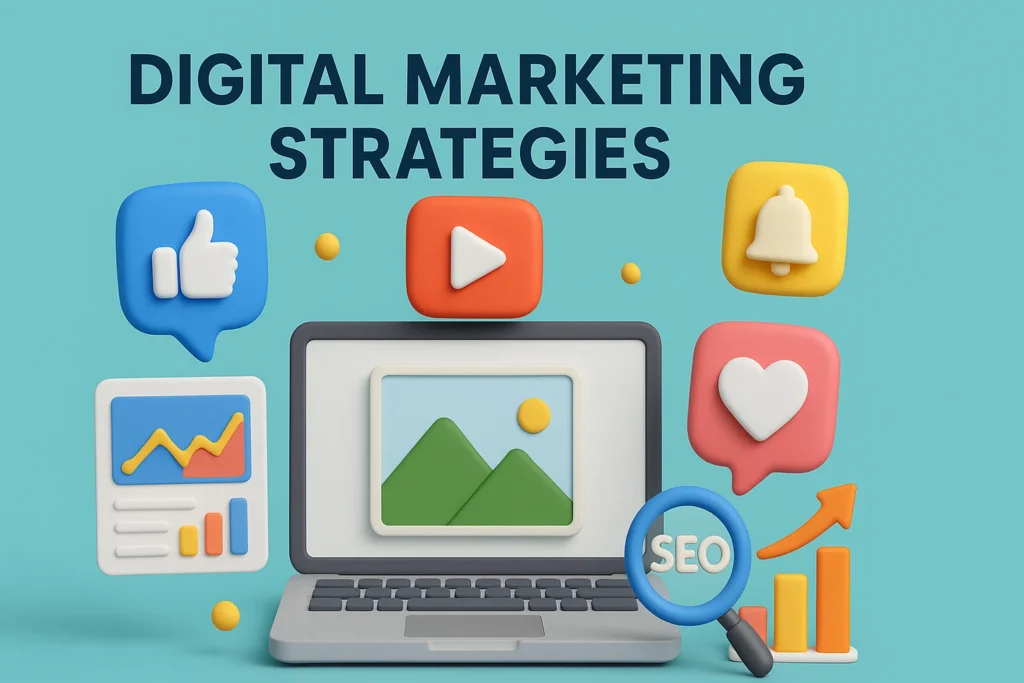How to Build a Strong Digital Marketing Strategy in 2025

Digital marketing never stands still. New platforms emerge, algorithms change, and consumers adopt different habits. This guide outlines the essential components of an effective digital marketing strategy for today’s competitive landscape.
Goal Setting
Every successful marketing campaign starts with clear objectives. Without specific targets, efforts become unfocused and results difficult to measure. The most effective approach uses SMART criteria: Specific, Measurable, Achievable, Relevant, and Time-bound. For example, rather than “improve website performance,” specify “increase monthly organic traffic by 35% and conversion rate by 15% within six months.”
Audience Research
Marketing effectiveness hinges on understanding the target audience. Comprehensive research should identify not just demographics which reveal basic characteristics, but psychographic information that uncovers motivations, values, and pain points. This deeper understanding enables truly relevant messaging. Creating detailed buyer personas documents basic demographic information, career and educational background, goals and challenges, information sources and preferred media, purchase decision factors, and objections and concerns. These profiles guide content creation, channel selection, and campaign messaging.
Channel Strategy
Digital channels multiply each year, but effectiveness varies by industry and audience. Most businesses benefit from concentrating resources on fewer channels rather than spreading efforts thinly. SEO remains fundamental for capturing high-intent traffic. Focus on technical website optimization, content that answers specific questions, local search presence when applicable, and mobile experience optimization. Content marketing builds authority and nurtures prospects through blog articles solving specific problems, case studies demonstrating results, whitepapers and research reports, and video tutorials and explanations. Social media requires platform-specific approaches. LinkedIn works best for professional content and industry insights, while Instagram excels at visual storytelling and lifestyle content. TikTok demands authentic, trend-responsive videos, and Facebook supports community building and targeted advertising. Email marketing delivers consistently strong ROI through welcome sequences for new subscribers, segmented campaigns based on behavior, personalized product recommendations, and abandoned cart recovery messages. Paid advertising accelerates results but requires careful management of search campaigns targeting purchase intent, retargeting to recapture interested prospects, lookalike audiences to expand reach, and platform-specific creative optimization.
Performance Measurement
Data collection and analysis separates successful marketing from wasteful spending. Establish dashboards tracking traffic metrics, engagement indicators, conversion data, and customer metrics including acquisition cost, lifetime value, and retention. Regular reporting should identify top-performing content and campaigns, conversion obstacles and drop-off points, ROI by channel and initiative, and opportunities for optimization. Testing methodology becomes critical for continued improvement through A/B testing landing pages, emails, and ad creative, experimenting with different offers and pricing, trying varied audience targeting parameters, and testing channel allocation and budget distribution.
Emerging Trends
The marketing landscape continues evolving. Forward-thinking brands should monitor voice search optimization as smart speakers and voice assistants gain popularity. This requires conversational keyword targeting, FAQ-structured content, featured snippet optimization, and local search presence. AI applications beyond basic automation include predictive analytics for customer behavior, dynamic content personalization, conversational marketing interfaces, and creative assistance and optimization. Immersive experiences engaging audiences in new ways include augmented reality product visualization, interactive content formats, virtual events and experiences, and community-driven content platforms. Purpose-driven messaging responding to consumer values includes sustainability initiatives and transparency, social responsibility programs, authentic brand storytelling, and community engagement and support.
Implementation Framework
Strategy execution determines success. Effective implementation requires clear task ownership and accountability, realistic timelines with built-in flexibility, resource allocation aligned with priorities, and regular progress reviews and adjustments. Common implementation pitfalls include inadequate team training on new tools, insufficient content production capacity, unrealistic timeline expectations, and failure to adjust based on initial results.
Conclusion
Digital marketing success in 2025 demands both strategic vision and tactical excellence. By establishing clear goals, understanding audience needs, selecting appropriate channels, measuring results, embracing innovation, and executing consistently, brands can build meaningful connections with customers and drive sustainable business growth.
